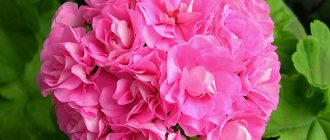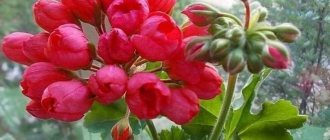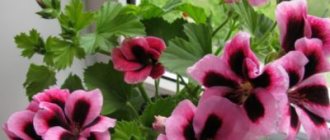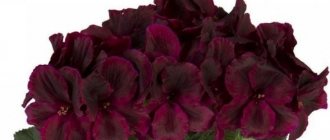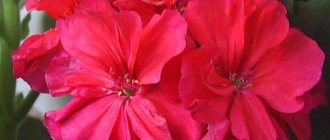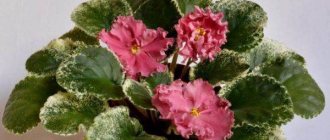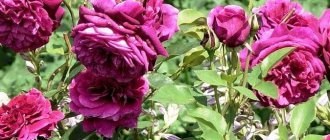Sutarves Klara San: brief description of the variety
Pelargonium Sutarves Klara Sun (see photo) at first glance is indistinguishable from Appleblossom Rosebud, which is not at all surprising - this particular variety was used for breeding work. The main difference lies in the different number of petals and buds in the inflorescence - Clara Sun can boast of greater terry and denser, fuller caps.
Pelargonium Sutarve Klara Sun
The average diameter of Sutarves Klara San flowers is 3-3.5 cm, but the variety grows large inflorescences. The color of the petals is quite unusual - the white buds are illuminated by a greenish core, with a pink border along the edge. Its saturation depends on the conditions of its maintenance - if you place the pot on a well-lit windowsill, the flowers “sunbathe” and become brighter, especially when grown in warm conditions. Coolness and lack of light allow you to get a less intense color in a pale version.
Sutarve Klara Sun has a fast growth rate - in just a year you can get a full-fledged bush. The plant tends to bloom at a young age, even with an unformed crown, but produces a large number of inflorescences upon reaching maturity (on average after 2 years). Budding takes a long time, often from spring to mid-autumn.
In order for the crown of Sutarves Klara San to develop harmoniously, the shoots need to be regularly pruned and pinched - this will stimulate the appearance of numerous lateral buds. If not properly cared for, the plant will produce one main shoot, turning into something like a palm tree. The recommended pot volume for adult bushes is approximately 2 liters; it is not advisable to use larger containers, since Clara San will devote all her energy to developing the earthen clod, and not to flowering.
'Sutarves Clara San'
'Sutarves Clara San'
Post by NataK » Jul 10, 2013, 9:59 pm
Pelargonium 'Sutarves Klara San' (Sutarve) Zonal, rosaceous pelargonium. In my opinion, it must be a strong growing plant.
This is the first flowering, there are 11 flowers in the cap.
Grows on a south window. Pot – 10.
I really like the shape of the flower. Flower size – 3 cm.
We're not the only ones who love flowers:
Re: Clara San (Sutarve)
Post by Passific » Jul 10, 2013, 11:33 pm
Natalya, thank you for introducing me to this variety.
In shape and color, Klara San and Apple Blossom Rosebud are very similar. It will be very cool if Klara San is more discreet and compact, unlike Apple
Post by Mila M » Jul 24, 2014, 4:56 pm
The variety is very beautiful!
Post by midas » 07 Sep 2014, 00:37
Post by MAK » 07 Sep 2014, 00:52
midas, and I have this variety that is much more compact than Apple Blossom Rosebud. True, their age and volume are different. This is how she grew up, her blossoms were paler, but there was less sun for her. Age - less than a year. And Apple Blossom Rosebud grew 2 liters and was 2 times healthier. Age 4 years. One hat is fresh, the second is already withered. Volume 1 liter.
Clara San
Post by ZLI » 03 Aug 2015, 22:54
Judging by the reviews, it is very similar to Apple Blossom Rosebud. But I only have Clara Sun, I can’t compare.
The plant is young, first flowering. The flowers are very cute.
I don’t presume to judge the character of pelargonium, this is my first season, it grew as I wanted, it stretched out a little, not mini.
a new peduncle breaks through the cap of flowers
Rules for growing pelargonium Sutarves Klara San
Sutarve Klara Sun needs conditions typical for zonal pelargoniums, that is, good lighting and warm content, a nutritious, but at the same time loose, permeable substrate.
Thus, growing pelargonium Sutarve Clara San comes down to several points:
- Lighting. It is preferable to have well-lit window sills that are exposed to the sun for several hours a day. On the south side, it is advisable to shade the pots so that the leaves do not suffer from burns; it is better not to grow them on northern windows;
- Watering. It is necessary to moisten the soil constantly, as the top layer of the substrate dries, but always in moderation. The earthen lump should neither dry out nor become waterlogged;
- Trimming. To obtain a compact bush with a harmonious crown, pelargonium must be pruned. Strong shortening of shoots is carried out at the end of February, sanitary pruning is carried out as necessary. Pinching the apical and lateral cuttings is also required;
- Feeding. During the period of bud formation and flowering, Sutarve Clara San must be fed using fertilizers for Geraniums or compositions for flowering indoor plants.
Features of cultivation
Pelargonium Angel is best grown in open ground conditions than in indoor conditions. Compact bushes are used to decorate balconies and terraces.
Pelargonium Angel is best grown in open ground conditions than in indoor conditions
Flowerpots are chosen according to the size of the bush, because flowers do not like large volumes of soil. It has been noticed that plants planted several times in one planting container show more luxuriant flowering than those planted individually.
Caring for Angel pelargoniums at home has its own characteristics. Plants need a break from growing and flowering during the winter. Plants cannot survive in open ground during frosts, so they are brought indoors for storage. The temperature in the room should not be higher than +12+15°C, the optimum is about +5+6°C. The appearance of flowering and its abundance depend on the storage temperature, because during this period the formation of future buds occurs.
In order for the bush to form neatly, with lush flowering, it is pruned in the spring, as well as after being moved from the street to the winter.
Additional Information. Not the entire plant can be harvested for storage, but only its cuttings.
Lighting affects the compactness of the bushes and the number of flowers, so it is preferable to place the pots in sunny areas.
Angel pelargoniums can withstand temporary drought and are demanding on drainage. Plants require moderate watering, with each subsequent watering carried out after the earthen clod has completely dried.
To stimulate abundant flowering, fertilizers with a high potassium content are used, applied 2 times a month throughout the entire growing season.
For continuous flowering, faded flowers are removed.
Pelargonium is most often affected by whitefly and spider mites.
The selection of pelargoniums does not stop; gardeners are presented with a variety of shades and shapes of bushes. The varieties are distinguished by their long-lasting decorative properties; flower pots can be taken outside as soon as the frosts end and left there until late autumn.
Pelargoniums of the Angel group are best adapted to growing outdoors, are drought-resistant, and easy to care for. The ceremonial white, pink, ruby shades of numerous flowers will become a real decoration of the garden.
Description of the variety
Pelargonium Sutarves Klara San was selected in 2016. It has double flowers that are highly decorative; due to the small number of petals, the bud does not open completely.
Pelargonium Sutarve Clara San - an ideal plant for true romantics
- The inflorescences are shaped like roses. The petals are pink, the middle is light green. Diameter - 3 cm.
- The buds are collected in inflorescences.
- The leaves are large, rich green in color. Each rounded leaf rests on its own long stem.
- Flowering continues from March to early November.
- Fast growth rate, within a year the plant develops into an adult shrub.
Note! The more light there is in the place where pelargonium or geranium is planted, the brighter and more saturated the pink petals will be.
Technical data of the plant
In Russia, indoor hybrids Fischers appleblossom pelargonium are popular, descriptions of which can be found in catalogs of companies selling plants. For this type of flower, the directory provides the following characteristics:
- The bush branches well. The seedling takes root 10-12 days after planting;
- leaves are round and green. They are bordered by a dark stripe;
- The hybrid's caps are quite tight. Large flowers are shaped like a rose. Their color can be white or reddish. Flowering lasts 4-6 months;
- the dimensions of Fischer pelargonium in the indoor version do not exceed 0.7-0.75 m in height. If it grows in a greenhouse, the height of the bush can reach 2 m.
Note! It is better not to leave geraniums in a room where the air temperature is below 14-15 °C. Under such conditions, the hybrid may get sick and die.
The plant has medicinal properties. It emits an extract that can relieve respiratory tract damage. This African subshrub is used to make an oil that calms the nervous system.
Similar varieties
Pelargonium Clara Sun is similar to some other decorative varieties related to geraniums.
This is another zonal pelargonium. Anna Sun is a bush up to 35 cm high, but very neat. Terry soft peach flowers are collected in a decorative inflorescence.
A distinctive feature of the variety is double snow-white flowers with a light pinkish tint. Pelargonium flowers Sutarve Nadya K are up to 3 cm in diameter, collected in inflorescences.
The bush is compact and does not lose its shape even without constant shaping. The leaves are rich green.
This variety of pelargonium is distinguished by elegant speckled petals. Snow-white flowers are decorated with pink edging and specks. The leaves are elegant, bright green.
For reference! There is another similar variety, which by the way does not belong to the Sutarves variety. Such a flower is the Alpenbloss Fischer pelargonium.
Story
Pelargoniums are native to South Africa, from which flowers and their seeds were imported to Europe in the mid-18th century.
The genus pelargonium belongs to the Geraniaceae family, which is why they are often called geraniums. In fact, pelargonium and geranium belong to different genera and are genetically different plants, between which breeding work is impossible.
The following groups belong to the pelargonium genus:
- zonal;
- royal;
- ivy-leaved;
- fragrant;
- Angels and Unicums.
Pelargonium Angel is not a miniature version of the royal group, as it is sometimes mistakenly represented, but a separate, less demanding species.
Pelargonium varieties Angel appeared from crossing the royal and curly species at the beginning of the twentieth century by the English florist Arthur Langley-Smith. The name Angel flowers comes from the Angeline hybrid, one of the predecessors of the new varieties.
Pelargonium Angel
Planting and transplanting
The plant is unpretentious, but it is important to provide it with normal care.
For pelargonium to grow and bloom, it is necessary to create optimal conditions for the plant.
Choosing a place and pot
The pelargonium variety Sutarves Klara Sun needs natural light, so place the plant on the south or southeast side.
However, in summer it is important to create openwork shading for the flower to protect it from direct rays of the sun.
A suitable pot diameter is approximately 2 cm larger than the projection of the crown. If you choose a larger container, the plant will spend a lot of energy on developing the root system, rather than growing and flowering.
Pelargonium Denise
Park rose Ferdinand Pichard: rules for growing and caring for the variety - review + video
For all planting material
Dozens of payment methods
Fast and convenient delivery
Russian Post (Moscow and region within 24 hours), SDEK, Courier
Pelargonium Denise (Denis).
Standard zonal rosebud pelargonium. Masterpiece of selection! The roses are very large, the inflorescences last about a month! The bush is strong and branches well. With age, it needs a large pot volume.
Planting pelargonium: Even a novice gardener can plant pelargonium in the garden - the process does not require compliance with any complex rules. You just need to remember about the long roots of the plant when digging holes about 20 cm deep. When planting, it is better to leave a distance of 20-30 cm between the bushes.
Caring for pelargonium: Pelargonium requires systematic moderate watering: the soil should not be allowed to dry out or there should be a large amount of moisture in the soil. The flower does not need spraying. Garden varieties of pelargonium do well in partial shade; flowering is weak in direct sunlight. Therefore, on particularly hot days, darkening is required. The optimal air temperature for garden plants is no more than +20 °C.
Soil for planting: Pelargonium Denise (Denis) is quite demanding on the soil. The ideal solution is unused, loose soil with good drainage. For young plants without a formed root system, light soil is more suitable, so sand and peat, vermiculite and perlite are added to the composition. The soil for planting must be sufficiently fertile and well-drained. Pelargonium should not be planted in loamy and clayey soils.
Preparing for winter: Already in the fall, the pot with the plant is placed in a cool and dimly lit place. A southern or northern window sill in a house/apartment is quite suitable for this, since there is diffused sunlight there. And to make up for the lack of light at this time, you can use fluorescent lamps. The optimal daylight hours are 12 hours.
Planting location: The ideal location in the garden for pelargonium Denise (Denis) would be sunny areas. However, even in partial shade it is able to fully develop and bloom profusely throughout the season.
Reproduction of pelargonium by cuttings: You need to prepare a sharp knife or scalpel and disinfect it with alcohol. In no case should you use a blunt instrument, as this can damage the tissue of the cuttings and slow down the growth of future roots. Cuttings are cut from shoots directed at right angles to the main one, and at least 3 leaves should grow on them. For tall varieties of geranium, the length of the cuttings should be about 5-7 cm, for short and miniature varieties - 2.5-4 cm. The cut is made at right angles to the stem.
Further care
In order for the plant to delight with elegant flowering, it is important to provide it with good care.
Pelargonium Clara Sun will be the pride of any gardener
Temperature
The optimal temperature for this variety of pelargonium is from +18 to +24 degrees; it is in such conditions that one can expect growth and beautiful flowering.
Watering and spraying, humidity
Pelargonium is afraid of swampy soil, but it is also afraid of excessive dryness. Watering is carried out as the soil dries; it is recommended to spray with a spray bottle every day in the summer, early in the morning. And in autumn, winter and early spring - no more than once a week.
To maintain optimal humidity for the plant, spray the air next to it.
Loosening
Careful loosening of the soil is useful after each irrigation; it promotes the supply of oxygen to the roots.
Feeding
In spring, the soil is enriched with a composition containing nitrogen. During the budding period - potassium-phosphorus complexes. Late autumn and winter suggest abandoning the use of fertilizers.
Note! Organic matter is harmful to pelargonium because it provokes root rot.
Trimming
The main task is to make the bush compact and neat. To do this, the top is pinched; this should be done in early spring. They work with a sharp knife, the cuts are disinfected with brilliant green.
Home care
Pelargonium came to us from the arid African continent, so it is unpretentious in care and does not require special skills.
Watering
Despite the fact that pelargonium is a drought-resistant plant, it must be watered regularly. This will preserve the riot of colors of the flower. In the hot season, irrigation is carried out once every 3-4 days, when the top layer of soil in the pot becomes dry. In winter, the soil should dry out to 1/3 of its depth. It is advisable to use settled or melted water, rain water (at room temperature).
Top dressing
Geraniums are fed during the period of active growth - from March to September. In winter, when the flower is resting, there is no need to feed it. The frequency of fertilization is once every 14 days. It is advisable to use phosphorus fertilizers.
Important! Flowering geraniums cannot be replanted. If you have flooded the flower, or the roots are exposed, add some fresh soil and wait until the flowering period ends.
Trimming
In order for the bush not to stretch out and have a beautiful compact shape, as well as to bloom more profusely, it must be periodically pruned. The procedure is carried out after winter. Living shoots are trimmed so that 2-5 buds remain. The dead and sick are removed completely. Dry and yellowed foliage is also trimmed. It needs to be trimmed, and not torn off, so that the plant is minimally injured. After flowering ends, remove dried umbrellas.
Transfer
Pelargonium does not like transplantation, so it must be done once or twice a year and only when you have discovered that:
- the roots filled the entire pot;
- the flower began to die due to waterlogging;
- the soil in the pot sank greatly and exposed the roots.
Having selected the pot, we begin replanting:
We recommend reading: How to replant indoor plants correctly and when?
- Disinfect the selected container if another flower previously grew in it.
- Place drainage made of small stones or crushed polystyrene foam at the bottom.
- Moisten the plant well and turn the pot over, remove the flower from it by slightly knocking on the sides of the pot.
- Inspect the roots for diseases and pests. Remove the affected ones.
- Place the geranium in a new pot and sprinkle with a mixture of two parts leaf soil, two parts humus and turf soil, and one part sand. You can choose another mixture: peat, humus, compost soil, sand, taken in equal proportions.
- Water the flower a little and place it in a dark place for 7 days. Then transfer it to the light. After two months, feed the little ball.
How does it reproduce
There are two methods of propagation - seed and cuttings.
Seeds are sown in January in nutrient soil. It is important that the temperature does not drop below +23 degrees. After two leaves appear on the seedlings, picking is carried out.
The most popular propagation option is cuttings. The top shoots about 8 cm long with 2-3 leaves are cut from the mother bush. The cutting is placed with the lower cut into a growth stimulator, then placed in nutrient soil for rooting.
Reproduction
Pelargonium Clara Sun propagates well at home using the method of dividing the bush, as well as by cuttings. It is better to carry out the breeding procedure either in early spring or in mid-late summer. In addition, seed propagation of the plant is also possible, however, in this case there will be much more trouble. Below are instructions regarding different methods of propagating pelargonium.
Seeds
In this case, the seeds are planted in the ground around January. The soil should be slightly moist and fairly loose and nutritious.
The top of the container with the planted seeds must be covered with polyethylene so that seedlings appear faster. The optimal air temperature outside is +20-24 degrees.
Periodically, the soil must be sprayed with a spray bottle. Shoots usually appear 15-20 days after planting the seeds.
As soon as a couple of leaves appear, it is recommended to pick the seedlings, and then continue growing for another two months. Then the strengthened sprouts are transplanted into separate pots.
Cuttings
To get full-fledged cuttings, it is recommended to cut off the lateral and apical shoots from the mother plant. The length of the cutting should not exceed 7 cm, and it must have at least 2-3 leaves. The cut must be sprinkled with activated carbon, and then the cutting must be dried for a couple of hours, wrapped in paper. After drying, the cuttings are planted in the ground, and the container should then be placed in a warm place.
When watering the soil, it is important to direct the stream only to the ground, without touching the leaves of the cutting. Otherwise, the shoot may rot before it has time to take root.
Within a month, with proper maintenance and care, the shoot takes root.
Pelargonium is an amazing indoor plant, because this flower has many interesting varieties, for example, Richard Hudson, Star, Millfield Rose, Anita, Rococo, Grandiflora, Red Pandora, Lady Gertrude, Patricia Andrea, Denise.
Growing problems and pests
Main pests: whitefly, spider mites, aphids. Insects are removed manually or insecticides are used.
An unpretentious flower with increased decorativeness - this is the amazing pelargonium Sutarve Clara Sun
The most dangerous disease is root rot. The reason is excessive watering. It cannot be treated and the plant will have to be disposed of.
If the leaves on the plant begin to fall off, this is a signal that its soil is poor and requires feeding.
Such is the delicate pelargonium Sutarve Clara San, a beautiful plant that is ready to become a worthy decoration of any interior.
Appearance
The advantage of the variety is that Pelargonium Clara blooms in an unusual way: its inflorescences resemble small roses.
The color of the petals is appropriate - very delicate pinkish with a light green center. The diameter of one bud is 3.5 cm. The buds are collected in lush inflorescences, giving the plant a special decorative appearance. Note that the flowering season of Clara pelargonium is very long - the plant pleases with its decorative effect from approximately March to November.
However, in order for the plant to bloom for so long, you will have to take good care of it: pelargonium Clara loves the sun, a not too voluminous pot, fertilizing and watering. Next, we will tell you about all the features of growing and care.
Other varieties similar to pelargonium Sutarves Klara San
The beautiful Clara Sun can be confused with her sisters who look like her.
Sutarves Anna Sun
Anna San is a bush with the same color. The difference between them is the size of the bush. Clara Sun is more compact than Anna.
Sutarves Nada K
The inflorescences of this pelargonium variety have a greenish core. But the rest of the color of the petals is white or pale pink, with dark pink splashes. The flowers of pelargonium sutarve Nadya K are not so stuffed.
Sutarves Igor
The leaves of this variety have a light spot in the center. The shape and color of the flower are also different. The Igor variety has double flowers of bright pink color with dark dots and stripes on the petals.
Planting and replanting pelargonium Clara San
Pelargonium Sutarve Clara San is not too capricious in home care. After the adaptation period, the first year of flower care is very important.
Choosing a place and pot
For pelargonium, select the most illuminated place in the house. If it is a south-facing window, it is important to shade it from the midday sun with transparent paper or fabric.
The pot for pelargonium needs to be small, otherwise the flower will actively grow its root mass. Drainage plays the main role; pelargonium does not tolerate stagnation of moisture.
Priming
The soil mixture should be as light and nutritious as possible. Leaf soil is diluted with peat, sand and turf in equal parts.
Important! Planting pelargonium is a process no different from planting ordinary geranium.
Where and how to plant it?
Lighting and location
If a gardener wants his pet to please the eye with its flowering for a long period, it is necessary to place the pot with the plant in a well-lit place. The flower does not like shadow. A window sill with windows facing south or southeast is perfect. But, it should be remembered that on too hot days, when the scorching rays of the sun penetrate the atmosphere, pelargonium should be shaded.
This can be done using a piece of fabric or translucent paper. Decorative flowering cannot be achieved if there is not enough sunlight.
Important! When Clara feels a lack of lighting, the color of its leaves fades, and the plant itself loses its decorative appearance. In addition, the stems stretch, which also affects the beauty.
In winter, you need to take care of additional light. You can use a special lamp.
Soil requirements
The flower has no special requirements for soil. More important than the soil is the drainage layer. There must be a layer of expanded clay at the bottom of the pot. Pelargonium has a negative attitude towards waterlogging. The delicate root system can easily rot in such conditions. The optimal soil for Clara Sun is neutral or slightly acidic. It is recommended to add ash to acidic soil.
Substrate composition:
- 1 part leaf soil;
- 1 part sand;
- peat and turf also 1 part each.
If the soil is not particularly nutritious, humus is added to it. In flower shops you can purchase ready-made soil, which is designed specifically for pelargonium.
Further care
To further care for Clara, it is important to focus on pruning, complementary feeding, hydration, and lighting.
Temperature
The optimal temperature in summer is 20-25 °C. In winter, not lower than 15 °C.
In summer, pelargonium grows well outdoors
Watering and spraying
The plant does not need spraying. The watering regime should be such that the substrate is constantly moist, but without stagnation of liquid in the roots. Watering is needed frequently and not abundantly.
Important! The plant has no special requirements for air humidity.
Loosening
If the soil is light enough, it is not necessary to loosen it. If a crust forms from frequent watering, loosen the soil in the pot from time to time.
Feeding
Fertilizers support the gorgeous and long-lasting flowering of Clara's pelargonium. Except for the winter period, complementary foods are introduced twice a month. Without proper nutrition, Clara san's buds may fall off during flowering.
It is important to know! Any complex fertilizers, except organic ones, can be used as fertilizers.
Trimming
Pruning in the first year shapes the size and compactness of the bush. Thanks to this procedure, the plant is given a beautiful shape. It also allows you to save energy for abundant flowering.
We grow beautiful things with our own hands! Pelargonium Denise: photos and care features
Pelargonium ingrid grycksbo
As mentioned above, Denise pelargonium is one of the most beloved plants by gardeners. Some of them call this variety Denis. On thematic forums there are literally queues for cuttings of this flower: flower growers are ready to shell out considerable sums for the shoot.
The plant belongs to the zonal rosebud varieties, therefore it has all the advantages of pelargoniums similar to roses. Among all rosebud pelargoniums, Denise is considered the most spectacular and most perfect flower.
The plant is not tall, unlike other rosebud species, but the bush still needs to be formed
Note that pruning in this case must be done carefully, since Denise does not really like this procedure. Who is the creator of this variety is still not known for certain. https://www.youtube.com/embed/XFlTqoufLs8
In addition, sellers of cuttings often sell other rosebud varieties for Denise, only externally similar to this variety. Therefore, it is best to purchase a plant from a nursery - this way there is less chance of running into a “fake” Denise
Who is the creator of this variety is still unknown for certain. In addition, sellers of cuttings often sell other rosebud varieties for Denise, only externally similar to this variety. Therefore, it is best to purchase a plant from a nursery - this way there is less chance of running into a “fake” Denise.
Plant propagation
Denis pelargonium reproduces in the same way as all its “neighbors” pelargonium: by seed and cuttings. When planting seeds, there is no guarantee that the plant will inherit all the characteristics and characteristics of the variety.
For this reason, rosebud pelargoniums are propagated exclusively by cuttings. Beginning flower growers often complain about rotting of planted cuttings. It is very disappointing when, with such difficulty, a cutting of your cherished dream - the beautiful Denizka - is acquired, but the efforts made do not bring the desired results, and the plant does not take root.
To avoid such disappointment, you can use the following recommendations:
- The optimal time for plant rooting occurs in March and lasts until July.
- Cuttings are taken from an adult plant. To do this, a cutting with 3-5 pairs of leaves is cut from a semi-lignified shoot. If you take a green grassy shoot, you won’t get a full-fledged cutting from it.
- The soil mixture for germinating a plant should be light and breathable, for example, peat + soil soil or coconut filler, the main thing is that the soil is neutral in acidity.
- The cuttings are dried on paper in the open air for one to two hours, the lower leaves are removed and planted in the ground, slightly buried in the ground.
- The planted cuttings are carefully watered, trying not to create excessive humidity.
- Water for irrigation is pre-settled for several hours at room temperature.
- Place the container with cuttings for rooting in a bright, well-lit room, for example, on a windowsill. In approximately half a month, the cuttings will acquire their first thin roots.
- As the flower grows, it is periodically fed with potassium-phosphorus complex fertilizers.
- In winter, the plant loses its decorative effect a little and practically does not bloom. Therefore, it is best to leave the rosebud dormant until spring, rarely water it and not apply any fertilizer. The recommended winter temperature for Denizok is only +10-15 degrees.
On a note. At the end of February, the pelargonium plant is moved to a warmer room, fed, and soon the bush begins to actively develop and by mid-summer pleases with its first buds.
Watering and spraying
The plant does not need spraying. The watering regime should be such that the substrate is constantly moist, but without stagnation of liquid in the roots. Watering is needed frequently and not abundantly.
Growing problems and pests
Aphids, whiteflies and spider mites can settle on Clara San if regular preventive treatments are not carried out on the plant. Improper watering or poor drainage can cause root rot.
Pelargonium variety Sutarves Klara Sun pleases with its flowering from March until November. It is enough to provide comfortable conditions for growth, and then the unusual hybrid will become a worthy decoration of the home.
Sources:
https://rastenia.info/tsvetyi/geran/sutarve-klara-sun-pelargoniya.html https://pocvetam.ru/komnatnye-rasteniya/tsvetushchie/pelargoniya-sutarve-klara-san.html https://greensotka. ru/tsvetushchie/pelargoniya-sutarve-klara-san.html
News
Check your orders for the availability of varieties and please make replacement varieties if they are not in the order. You can write about replacing varieties by email: be sure to indicate the order number in the letter, or leave the information in your personal account.
PLEASE MAKE REPLACEMENTS BEFORE JULY 24, AS THERE IS A LINE OF THOSE WHO WANT TO BUY PELARGONIA FROM A FREE WAREHOUSE.
Photos of varieties with prices will be posted on the website in the pelargonium section - coming soon. The price for pelargonium will be from 450 rubles to 750 rubles, prepaid varieties cannot be recalculated.
| Anni Mummon |
| Chelsea Diane |
| Lara Marjorie |
| Mallorca |
| My chance |
| A Happy Thought |
| Achievement |
| Achievement |
| Ainsdale Duke |
| akos farmor |
| AlisonMarch |
| Americana white splash |
| Ansbrook Mulberry Blotch (Annie Parmenter, 2009) |
| Appleblossom Rosebud |
| April Snow Rosebud |
| Arbra |
| Artic Princess |
| Asarnas Tor |
| Asgerd (West&Lundberg) |
| Attar of Roses |
| Baby Brocade |
| Barbe Bleue |
| Bell Ernie Oliver (Steve Pollard) – Nyhet! |
| Bernice Ladroot (Jay Kapac) |
| Betwix/Lass O Gowrie |
| Blue Sybil |
| Bold Minstrel |
| Bold Pixie |
| Bonny |
| Bornholm |
| Brightstone |
| Brocade |
| Brollopspelargon/ Nanny |
| Brookside Fantasy (Hopkins) |
| Brookside House of Orange |
| Camisole |
| Camisole (Shady Hill, USA) |
| Capri |
| Carmel |
| Carmel (Schmith, 1947) |
| Carmen Andrea |
| Carole Munroe |
| Charles Ground |
| Chelsea Star |
| Chocolate Heaven |
| Choun Cho |
| Cirkus |
| Clatterford |
| Colibri. |
| Concoulor Lace (Filbert) |
| Cook`s Scarlet and White (Cook, 1962) |
| Costa Daurada Burgundy |
| Cotta Lilac Queen |
| Dagmar Murray – Nyhet! |
| Diana Palmer |
| Dick Key |
| Diemierii Schafferi |
| Don Chiverton |
| Don´s Richard A Costain |
| Dood´s Super Double |
| Dovepoint |
| Dream Lover |
| Drottning Victoria Vilohem |
| Drottningholm |
| Dylan Cherone |
| Edward Embers |
| Edward's Elegance |
| Edwards Blanche (M Edwards, Australian) – Nyhet! |
| Edwards Calico |
| Edwards Caris |
| Edwards Embers |
| Edwards Tamara (M Edwards) – Nyhet! |
| Elisabet S. fren Visby |
| Elnaryds Alizia |
| Elnaryds Ebon |
| Elnaryds Miranda |
| Emma fran Bengtsbo |
| EmmaSpohie |
| Emperor Nicholas |
| ERAs Estelle |
| ERAs Victoria |
| Fir Trees Silver Wedding |
| Fischers Appleblossom |
| Freak Of Nature |
| Freshfields Suki |
| Friary Wood (Peat) |
| Fringed Patricia Andrea |
| Garnet Rosebud |
| Garten Director Herman |
| Gerda |
| Glowing Ember |
| Goldstone Cooper |
| Good Vibration |
| Gosbrook Clifford Taylor' |
| Gosbrook Ryan David |
| Gray Lady Plymouth" |
| Groszer Garten Weiss |
| Happy Anniversary |
| Happy Birthday |
| Harlequin Ted O'Day |
| Helen Christine (P Hugo) |
| Hero |
| High Tor (Portas) |
| Highfield's Attracta |
| Highfield's Sugar Candy |
| Honeywood Suzanne |
| Hulverstone |
| Ice Rose |
| Ingemundeborosen |
| Irene Modesty |
| Iris Mepham |
| Jacey |
| Jacky Gould |
| Jacqui Caws (B West) |
| Janet |
| Janet |
| Jips John Morbey |
| Jip's Little Gaude |
| Jip's Meg |
| Joan Morf |
| Joann Hodgson |
| Johanna fr Sattraby |
| John Lardy |
| JUST JIP |
| Kattbos Anna. |
| Kelly Brougham (B West) |
| Lady Gertrude |
| Lara Peter – Zonartic |
| Leufsta |
| Lilian Andrea fr. Scrgerden |
| Linghed (Fren Dalarna) |
| Linnea Andrea |
| Little Glitter |
| Little Linda |
| Little Spikey' |
| Madame Salleron |
| Mallorca/Swiss Star (T Conk, 2003) |
| Margery Stimpson |
| Martha Parmer |
| Maureen |
| Michael |
| Millfield Gem syn.Victory Lady Brooke (Victor Lemoine, 1894) 1 |
| Minah's Cascade |
| Mini Diane |
| Monseruds Rosen |
| Monseruds Rosen – Nyhet! |
| Mr. Parker |
| Mrs. Pollock (1858) |
| New Gypsy |
| Newbridge |
| Noel Gordon (Washbrooke) |
| Odensjö Leonora |
| Odensjö Ljus och Varme |
| Odensjö Stilla Flirt |
| ODENSJO SUZIE WONG |
| Odensjo Vanessa.. |
| Orange Glitter |
| P. cotyledonis |
| Patricia Andrea (Andrea Nursery, 1967) |
| Paul West |
| Peter Beard |
| Picotte Pink |
| Pink Needles (B West) |
| Pink Snow |
| Point South |
| Potter Heigham |
| Powder Puff |
| Princess Abigail |
| Priory Coral (B West) |
| Priory Salmon |
| Purple Prince |
| Quantoc Perfection (Ken Dymond, 2009) |
| Rager's Pink |
| Ray Bidwell |
| Red Janet Hoffman |
| Richard Upward |
| Rococo |
| Rollerґs David |
| Rose of Bulgaria |
| Royal Black Rose |
| Ruby Rosebud |
| Rushmoor Golden Ruffles |
| Rushmoor Platinum Anniversary |
| Rushmoore Rhapsody |
| Sammi Brougham |
| santa maria centennial |
| Sarah Hunt |
| Scarlet Rambler |
| Shannon Corr (B West) |
| Sharon Louise (B West) |
| Silver Lady |
| Silver Wings (Neville West) |
| Sister Henry |
| Sophie Emma (A Stubbs) – Nyhet! |
| Sophie Marion |
| South African Sun |
| Southern Peaches |
| Star Flair |
| Star Flair (B West) |
| Stilleryd |
| Sutarve Clara Sun |
| sutarve tomas k |
| Sutarve's Sava |
| Sutarves AnnaSan |
| Swainham Golden Girl (Jill Leach) |
| Swainham Limelight (Jill Leach) |
| Swainham Pomegranate |
| Swanland Pink |
| TANT HANNA |
| Tara Caws |
| Thomas Earl' |
| Thornland's Marble |
| Toskana Cleo |
| Trumphs (Hill) |
| Ulleoborgs University |
| Ungarisk Appleblossom |
| Ungarisk Appleblossom |
| Unicorn Monday Morning |
| Vectis Embers |
| Vectis Finery |
| Vestis Storm |
| Warrenorth Citrine (A Simmons) |
| Warrenorth Platinum |
| Wedding Roya |
| Wendy Read' |
| Westdale Appleblossom (C Clarke, 1997) |
| White Butterfly |
| Zeebra Lee |
| Zoe Kathleen |
LIST OF VARIETIES THAT WILL ARRIVE INTO WAREHOUSE AFTER AUGUST 15 (DELIVERY)

